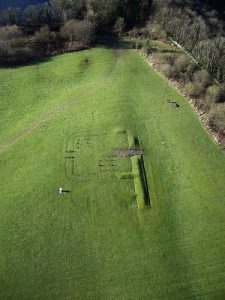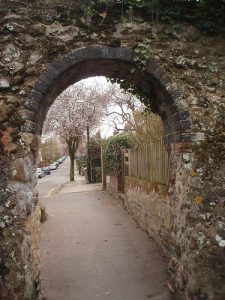“Are there even 10 Roman walls in Britain?” I hear you ask… Read on and see for yourselves.
1. Hadrian’s Wall
The Roman wall.
By a distance the most famous Roman ruin in Britain, Hadrian’s wall was a way for the Romans to do more than just protect the northern border of the Empire. It marked their territory in a way that would leave those who came against it in awe. It was a protective measure, designed as an impassable obstacle to any invader, but also a controlling structure, monitoring trade across the border and collecting levies. The strength of the wall was bolstered by the serrated hillsides surrounding it.
The wall – originally wooden? – is 84 miles long. It had 16 permanent sentry points along its route and was around three and-a-half metres high, with variation along the route. It was constructed with locally available materials: stone blocks in
the east, and a combination of turf and cobbles in the west. In front of the wall a ditch was dug to further increase the gap from the top of the wall to ground level, and behind it was another ditch as a last resort defence. Hadrian commissioned the wall in 122 AD, and it took about five years to complete the project, one of the most ambitious of all Roman constructions.
A reminder of the incredible scale and scope of the Roman empire is that auxiliary archers from Syria were brought to serve on the wall. Exactly what they must have felt about being positioned here we can only imagine, waiting on the wall for the occasional sight of a red-haired Scot, but otherwise alone with the bleakness, cold, rain and mist in the spectacular, rugged terrain. If you’re ever able to visit the wall, particularly around the Vindolanda fort, you really should go (an excellent occasion for this could be the spectacular light show planned along the 84 miles of wall on March 13th). Looking out along the remainder of the wall, depleted by so many years of scavenging medieval builders but still impressive, it is a very evocative experience and strong reminder of the reach of Rome.
2. Antonine Wall

Much less well known than Hadrians’ Wall, the Antonine Wall was the genuine northern end point of Roman expansion. The emperor Antoninus Pius – Antoninus Pius was Hadrian’s adopted son and successor from the years 138 to 161 – ordered its construction in 142 AD.
The wall bisects Scotland from the Firth of Forth to the River Clyde. For twenty years it was guarded by sentries housed in sixteen forts, connected by a road known as the ‘Military Way’. Unlike Hadrian’s wall, this wall was constructed from turf across its length with additional timber battlements, but it matched Hadrian’s wall for height (around three and-a-half meters). Similarly it also had a ditch cut in front of it to make it that much harder to scale.
It took about 12 years to complete the 39 miles of wall, and inscriptions on stones set within the wall tell us which legions took part in construction. After only 20 years the wall was abandoned and in 162 AD the border retreated back to the stronghold of Hadrian’s wall, perhaps due to a defeat against the Caledonian tribes.
In recent times the Scottish government set about trying to get the wall recognised as a UNESCO World Heritage Site; consequently it now shares in the World Heritage status of Hadrian’s wall and the northern fortifications of the Roman Empire.
3. London Roman Wall
Many mistakenly believe building a wall around the growing settlement of Londinium was one of the Roman’s first priorities upon founding the soon flourishing settlement. Not so, for the construction of the bridge and ports were foremost in their minds. If they had come to build the wall sooner it may have saved London from destruction in 60 AD, at the hands of Boudica. But better late than never.
Video: Londinium & The London Wall
At the end of the second century the wall was extended after raids by Northern Germanic pirates, and an additional section connected the wall to the banks of the Thames (this section is now within the grounds of the Tower of London). It added considerable additional protection to the fort which was built (circa 120) next to the site now housing the Museum of London.
London’s Roman wall had six gates, which survive as modern place names: Aldgate, Aldersgate, Ludgate, Cripplegate, Newgate and Bishopsgate.
Vast quantities of ragstone were shipped downriver from Kent to provide the 85,000 tons or so required to build the wall. For around 1,000 years the wall (along with later additions to it) was used as a defensive fortification and to monitor goings on within the trade hub of the city of London. It is quite possible that without the wall to protect it, London’s financial district would not have grown as strong as it did. For this reason I’m putting this wall at number three in this list.
Although most of the wall was demolished in the 18th century, what was left of it stood firm even throughout the Blitz. You’ve got to hand it to those Romans, they really new how to build to stand the test of time.
4. Colchester
Camulodunum was the first settlement on the British isles to see urban construction and the use of stone and brickwork. Claudius‘ conquering force built a hill fort looking down over the town below, followed by the veterans staking claim to the surrounding lands, making the first city in Britain. Boudica laid waste to the city in the year 60, but by 65 it had recovered and new city walls were in place to prevent such an incident occurring again.
A number of impressive gateways are still standing, such as the Balkerne gate, a twin doored construction with grey stone blocks positioned over characteristically Roman red brick arches.

Chunks of Roman wall are still dotted around the city, often seeming incongruous to their surroundings, not least the section which has had a pub built into the gateway, this pub is appropriately named the ‘whole in the wall’. In another place a thin section of the wall is sandwiched in the gap of less than half a metre between two shops.
What is most fascinating about Colchester’s wall is the numerous ways it has been adapted into people’s lives over the centuries, with gateways reused as entrances to the town park, Roman drains still doing their jobs in a front garden, and patches of Roman tiling found amongst the rebuilt medieval and victorian wall sections- it adds a lot to the charm of Colchester.
5. York’s ‘Roman’ Walls
York city has more miles of intact city wall than any other settlement in Britain. Admittedly not very much of this wall is the Roman wall, or even on the same path of the Roman wall, but residents still refer to it as ‘the Roman wall’.
York’s Roman name was Eboracum, and it was home to the emperor Severinus from 209 to 211 AD. It was he who had the most distinguishing feature of the walls built, the ‘Multangular Tower’ which is now well preserved in the city park, connected to a very well preserved section of curtain wall made from stonework interspersed with Roman bricks. This tower was one of eight; it has ten sides and is nine metres high. Although the higher levels of the tower were rebuilt during medieval times, the foundations and lower parts are still original Roman masonry. The Romans had built a fort upon the site back in 71 AD, with 5,000 men stationed there. This fort on the banks of the River Ouse soon became a town and that town a city – perhaps one more often associated with the Vikings, who left their own legacy through their extensive and well preserved walls. For some more information about York in antiquity take a look at this.
6. Chester’s City Wall
Despite the collapse of a 30 metre stretch of the wall in 2008, the Chester walls (currently being restored) are still the most intact city wall in Britain. They started life as wood and turf palisades, and from the 1st to the 3rd centuries AD these were gradually replaced by stone. The stone walls standing in progressive disrepair until the time of Queen Æthelflæd (daughter of Alfred the Great) who ordered refortification of Chester to counter Viking encroachment. The walls were bolstered further during the English civil war (1641-51). Repairs of the collapsed section of the wall are ongoing, with archaeologists doing their utmost to ensure restoration follows authentic Roman construction methods – the collapse has not all been bad. In December 2009, during the reconstruction process, another Roman tower was discovered buried along the route of the wall. Amuse yourself by watching repairs to the damaged section live on this webcam!
7. Chichester
Chichester is built on the foundations of the Roman southerly outpost of Noviomagus Reginorum. Chichester’s city defences developed step-by-step in the Roman period, the first stage was the construction of flint walls some seven metres thick. In the middle of the third century bastions were added. Unlike London or Chester, Chichester (in Sussex, on the South Coast of England) has not grown vastly from its Roman ancestral town. With 25,000 inhabitants, it has retained many of the elements of the Roman town shape, such as the cross road running through the town centre. Chichester’s current walls are built on the Roman walls underneath, which were once seven metres high but have been diminished when taken for use in other buildings in the town.

8. St. Albans
The Roman wall at Verulamium has seen better days… but there is some of it left which is quite remarkable. It was built in the third century, and was thought to once be 2.3 miles long, about 4 metres tall, and a formidable 2 and a half metres thick. Now around just 30 metres remain of this third century fortification. It’s a Roman wall though, so it’s going on the list.
The wall came with the obligatory ditch, and was made from flint and tiles. Large bastions on the south side of the wall gave visitors from Londinium the impression they were arriving at the next stronghold to the north of the capital. Veralamium was one of the three major settlements in Southern England in the early days of the Roman conquest, along with Camulodunum and the trade hub Londinium.
9. Leicester’s Jewry Wall
Though not a city or protective wall, the Jewry Wall warrants mention. It is part of a bathhouse and was once the wall separating the Frigidarium and Gymnasium inside that building. The wall is the largest surviving single part of a non-military Roman structure in the UK, so named because it was a meeting place for judges who sat as a jury. It now has its own museum to accompany it, so visitors to Leicester, you know where to go. If you won’t be visiting Leicester in person, you can see Roman Leicester (Patae Corieltauvorum to give the Roman name, which I challenge you to pronounce) brought to life by animators.
10. You Tell Me…
If you’re reading this seething because your local Roman wall is not included in the list, or astounded by my ignorance of a famous Roman wall in the UK, let me know. If you have visited the walls in Exeter or Canterbury and can comment about those, it would be great to hear what you have to say. What Roman wall do you think should be on here to complete the set of Britain’s best?
